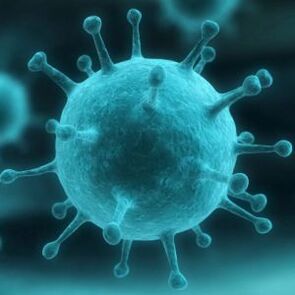
Papilloma is a benign skin cancer, its distinctive feature is a papillary base of connective tissue covered by the top epithelium. Papillomas occur in humans in different areas of the body (on the skin, mucous membranes, in internal organs and other sites) and in most animals.
Papillomas develop from the transitional or squamous epithelium into a soft dense formation on the so-called stalk. The size of these formations is usually 1 to 2 cm in diameter, and their outer surface is white or dirty brown. Sometimes the papilloma develops in different directions and becomes like a cauliflower or chicken coop.
The papillomas are removed for an aesthetic effect if they appear on visible areas of the body - on the neck, arms, face, however, if they appear in multiple areas of the mucous membraneOn the larynx, for example, circulatory disorders can be life-threatening. In the case of the larynx, papillomas can obstruct the airways, make it difficult to speak or breathe normally, in the case of the bladder, the papilloma causes hematuria. If more papillomas are formed on the body, then this indicates the onset of papilloma.
The etiology of papilloma
For the most part, papillomas are caused by viral infections - human papillomavirus (HPV), although sometimes papillomas can occur either congenitally or as complications of inflammatory diseases.
When HPV enters the human body, its activity usually begins to manifest after a long time. Usually, a number of provoking factors contribute to the activation of the papillomavirus virus, so soft tumors begin to appear on the skin or mucous membranes. Experts believe that stress, reduced immunity, treatment-induced weakness, vitamin deficiency in the body, and skin injury are the main factors that cause papillomas.
Basically, people are sexually infected with papillomavirus, however, domestic infections with very low immunity or damaged areas of the body that can come into contact with people. HPV carriers can also occur. The appearance of the papilloma indicates activation of the existing virus, which is equally likely to occur in women and men. Babies can become infected with the virus by passing through the birth canal of an infected mother.

Classification of HPV manifestations
Human papillomaviruses that infect mucous membranes and skin can be classified into the following categories:
- Clinical form
- can be detected during the routine examination: genital warts, warts and papillomas, exogenous warts, as well as cervicitis and cervical erosion inwomen;
- subclinical form, in which forms are asymptomatic, are not visible and they can only be detected during endoscopy: inverted form (develops into the inside of the mucosa), flat warts, as well as warts in the cervical canal;
- latent form, characterized by no clinic and detected only by analytical results;
- female or cervical form, manifested by cervical cancer or dysplasia at different stages.
When a woman is infected with a highly cancer-causing HPV virus through sex, the chance of a malignant tumor appearing in the cervical canal increases significantly. When infected with other viruses, the likelihood of cancer chemistry is not high, however, cancer cancers can appear in the rectum or oral cavity. In men, the chance of getting cancer from the HPV virus exists in the anus, penis, and rectum.
Types and types of papillomas
It is very important to know exactly which papilloma appears on the body. These viruses depend directly on the strains of viruses that form, when entering the human body, contributing to the excessive cell division of the skin, leading to papilloma.
HPV strains can cause cancer and are not carcinogenic. There are more types that are not carcinogenic and they, as a rule, do nothing to the patient except for external cosmetic discomfort.
Such expression can be easily removed, thus solving the problem. However, if a tumor arises in the mucous membrane, this indicates serious pathological processes. Such dislocation means that a person has been infected with a cancer-causing strain of HPV, so complex antiviral therapy is essential. To distinguish between different types of papillomas, it is sufficient to compare them with each other and determine the distinctive characteristics of one or another subspecies.

Simple warts
Simple papilloma or warts is the most common papilloma virus caused by several strains at the same time. These strains of HPV are not only transmitted sexually but also through contact and daily life, which leads to statistics indicating that 30% of the world's population has encountered this type of HPV at least once in the past. life.
Simple papillomas or (common) vulvar warts are usually localized on the upper extremities, particularly on the hands, but sometimes they can also appear on the body, soles of the feet, and the table. feet, palms, fingers. Their special feature is that such warts appear in areas of skin damaged by reduced local immunity. Such papillomas occur in the soles of the feet or palms due to exposure to poor quality household chemicals, excessive sweating, various skin lesions, dermatitis.
The wart looks like a skin papule a few millimeters in diameter at the beginning of the illness. In this case, the first part of the wart has a uniform texture, soft and protruding above the skin surface. It is poorly pigmented, and its root goes deep into the skin, where it receives nutrition from the vessels. As a result of such a diet, warts gradually develop, while not only changing their size but also the level of pigmentation. In addition, hair often grows in the center of such papillomas, this is a variant of the norm and does not indicate a malignant tumor.
Flat papilloma
Patches like these look like small, flat yellow patches that are slightly protruding from the surface of the skin. Their dense structure, deep under the skin, is evidenced by frequent pain when pressed against pimples or when damaged in everyday life. Localization of such papillomas is usually the face and hands. They can sometimes appear on the anus or on the labia in women and in the scrotum in men. Due to the positive blood supply, they tend to increase positively.
The main feature of a flat papilloma is that it is difficult to treat. After surgical treatment of these tumors, the scars and scars usually remain in place.
Genital warts
Genital warts occur in the groin or mucous membranes. On the outside, these are thin papillomas 2-3 mm in diameter. Such papillomas rapidly develop, forming a large patch of skin that develops from a single small papilla, like cauliflower or a honeycomb.
The main danger of genital warts is a high risk of infection, inflammation, and tumors in the vagina or labia in women. They can be easily injured, then the infection enters the body at a high rate. Also, a major problem associated with genital warts is the high risk of recurrence, which does not decrease even with antiviral treatment and tumor removal. Certain strains of the virus can cause genital warts, some can endanger women with the malignant process.

Fibrous papilloma
Filamentous papillae with a thin body, apex with the tip of the tumor's head. They are difficult to confuse with other species due to their special appearance, so just looking at the photo of the filamentous papillomas we can distinguish them from other varieties.
Such tumors most often appear after the age of 45 in the predominantly thin areas of skin - on the chest, underarms, on the neck. The increase in the size of such tumors is due to their elongation. The tip of the filamentous papilloma is usually yellowish or pinkish in color, with no pigmentation, often very weak.
Inner Mole
Any tumor on the surface of a person's internal organs can be classified as a subgroup of internal moles. These are tumors in the stomach, papillomas in the rectum, tumors in the throat and mouth, tumors in the bladder wall. A distinctive feature of these papillomas is that they cannot be identified without proper medical procedures and diagnosis. However, the disease can be suspected by special symptoms. The danger of such tumors is determined in each case.
If there are papillomas in the bladder, bleeding or cancer can develop over time.
If the papilloma is located in the larynx, it will obstruct breathing and interfere with the person's speech function.
Lewandowski-Lutz papilloma
Lewandowski-Lutz epidermal dysplasia or papilloma is a very rare condition that primarily affects children or adolescents. It happens that such a disease can be inherited and spread within a family.
The clinical picture of the disease manifests itself as multiple reddish-brown spot warts on the feet and hands. One feature of the pathology is the fact that when papillomas are located on areas of the body exposed to ultraviolet radiation, in one third of cases they regenerate into a malignant tumor and develop into thearea of neighboring tissues.

Location of papilloma
Filamentous, coarse or pointed papillomas, as well as papillomas, are the most common types in physician practice. The localized localization of fibrous warts is the face, coarse warts are usually located in the area of the feet or hands, and the warts are only on the mucous membranes (the tip of the penis and urethra in men, in the area of the labia. vulva and vagina in women), but it happens any of these warts can happen in an unusual place for themselves.
It is not difficult to remove such papillomas in modern conditions, but the danger is that with a decrease in immunity a new papilloma may reappear, leading to more serious consequences onhealth, for example genital warts that appear later lead to cervical cancer in women in utero. Tree warts are most common on rough soles of the feet and toes. Occasionally, spikes can develop on the thumb after the skin is severely damaged.
In general, papilloma is a generalized form of pathology in which tumors form throughout the human body. These pimples have a characteristic appearance, so once one has seen the manifestation of the disease it cannot be confused with any other disease.
Symptoms of HPV
The most common symptom of papilloma in the human body is the appearance of papillomas on the skin.
The rest of symptoms directly depend on the location and type of disease. Depending on the signs above, symptoms of HPV can be as follows:
- Genital warts occur on the mucous membranes of the genitals, mouth, larynx, rectum, and on the inner surface of the stomach. Symptoms at the onset of vaginal disease are itching and an unpleasant odor. If such symptoms start to bother, in no case should they ignore them, as very often the cause of it may be due to its carcinogenic nature.
- Inline papilloma in the ductal area of the mammary gland, marked by redness in the nipple area, slightly itchy and burning. In addition, if you press on the nipple with such a papilloma, a green or green discharge begins to drain from it. The danger of oviductal papillomas is gradual and possible deterioration of breast cancer.
- Plantar warts manifest as active calluses on the soles of the feet, and walking or pressing on them causes pain in a sharp form.
- Papillary neoplasms in the laryngeal area initially do not manifest with any specific symptoms, but gradually this pathology leads to changes in one's voice, a feeling of lethargy in the throat and impairedrespiratory function. In addition, the patient began to experience difficulty swallowing.
- Flat teen warts are most common on the outer face of the hands and the lower part of the face. Symptoms are very faint and often manifested by a rare, mild itch of the tumor.

Mechanism of pathogenesis
In the presence of HPV in the human body, it can often be concluded that the immune system is impaired. Once inside the body, the virus begins to infect the basal epithelium, creating a primary tendency to affect the area of the transition from the squamous to the cylindrical epithelium. In infected cells, there may exist 2 forms of the virus - peripheral (in addition to the cell chromosome) with a benign and intracellular nature (integrated into the cell genome) with the malignant nature of the parasite. born.
Incubation period of the papillomavirus virus can vary from the time the virus enters the body to the first manifestation of the disease from 14 days to several years. The nature of the papillomavirus infection in humans is often latent, that is, hidden. At the same time, several types of pathologies can settle in the human body at the same time, and under the influence of certain factors, each of them can begin to manifest through active reproduction. In this case, a stage of the disease arises, at which the clinical manifestations begin to be identified.
Very often (up to 90% of all HPV infections), the human body cures itself within 6-12 months, but in the remaining 10%, the disease can become chronic. charged with the long duration, recurrence and malignancy of the process.
Diagnosis
Ultrasound of papilloma
When diagnosing papilloma, ultrasound is not used as the primary research method but as an additional method, confirming the correctness of the alleged diagnosis. Essentially, ultrasound is used to diagnose papillomas in internal organs when they turn malignant.
Ultrasound is used among the instrumental verification techniques for diagnosing papillomas in fallopian tubes.
Conducting an ultrasound in this case does not allow the therapist to examine the ducts of the mammary gland, however, it helps to differentiate an oviductal papilloma from a suspected breast cancer, which can be ruled out. inflammatory mammary gland disease in mammary adenomas. In addition, an ultrasound can help detect the appearance of a papillary bladder tumor. However, ultrasound in this case is only effective if the tumor exceeds 1 cm in diameter.

Diagnose PCR when making diagnosis
The diagnosis of the disease in question is carried out by a doctor, dermatologist and dermatologist. Since the number of strains of the virus is so diverse, it is important to determine the exact type of infection a patient has and whether this strain of the virus has carcinogenic properties. With the naked eye, an accurate diagnosis can only be made in the case of classical genital warts, which is why if an HPV infection is suspected, specialist doctors always use shaving PCR.
Polymerase Chain Reaction (PCR) invites researchers to not only determine the presence of HPV in the body, but also demonstrate the type, carcinogenicity and number of the virus at the time of diagnosis. This is important in diagnostic terms, because if there is information about the percentage of the virus in the body, it is possible to determine the approximate time of infection and determine who is in contact with the patient to proceed. therapy for the cause.
Based on the PCR diagnostic results, it is possible to determine the course of a chronic infection or a one-off outbreak due to reduced immunity. This information gives the therapist the opportunity to prescribe the right therapy for each particular case. Usually, PCR diagnosis is done in the form of a screening. If the presence of the virus in the body is confirmed, the patient should continue to be examined with other techniques.
HPV biopsy
A medical biopsy refers to the process of taking a sample of human tissue for later examination by staining with a special dye. Biopsy is very common for cancer, as is suspected HPV. Before treating a papilloma, the doctor must rule out the cancerous nature of the tumor.
Biopsy is a highly accurate diagnostic technique that, if HPV is suspected, can be manifested in cytological or histological studies.
Cytology is a microscopic study of body cells, designed to demonstrate to the specialist the changes caused by the viral infection in these cells. . For the prevention and early detection of cervical cancer, cells for cytology in a woman are obtained from this organ. If cancer-causing HPV types are detected in women, even in the absence of external manifestations and signs, cytological studies will be ordered annually for them, allowing them to promptly detect thesesigns of cervical dysplasia. The fact is that dysplasia of this organ is completely curable, and if you do not start developing, then cervical cancer in the body will not develop at all, even with one type. cancer causing virus.
For an accurate diagnosis of HPV, a histological study is performed, in which it is not necessary to take a sample of the superficial cells from the patient for analysis but a piece of tissue in order to check the exact location of thecell layers, tissue characteristics and characterizes cancer. When conducting histological examination with the help of solution, the obtained tissue sample is dehydrated and immersed in paraffin, which is then formed with microtomers, allowing layers of thickness 0, 1 to be obtained. mm. The removed layers are stained with a special dye to reveal pathological cells during microscopic examination and to determine their nature.

Treatment of papilloma
Papillomavirus treatment is always done under an individual program. If the virus is detected during diagnosis but still shows no symptoms, the patient is prescribed etiotropic cytostatic therapy, which acts to "lull the virus" for several years.
If a person is a carrier of the HPV virus, then they should regularly have PCR testing to determine early signs of disease development. In addition, carriers of the virus are forced to use barrier contraception so as not to infect their sexual partners.
When detecting papilloma, it is imperative to use antiviral drugs in treatment. In general, immunomodulatory and vitamin preparations are indicated for all patients with HPV infection.
When papillomas appear on mucous membranes or skin, depending on the location and symptoms, cryotherapy, coagulation and laser removal are used. Sometimes the papilloma is removed with a more modern technique - using radio waves. In the case of signs of papilloma malignancy, it is surgically removed along with the surrounding healthy tissue growing. It is also important to know that removing the papilloma does not lead to a complete cure, since the virus remains in the body and may return.
Modern medicine does not have any drugs to completely remove this virus from the body, so when such a diagnosis is made, even in the absence of a manifestation, the patient mustRegular examinations to determine the development of the disease.
Since the papillomavirus is usually sexually transmitted, it is essential to use barrier methods of contraception and if a woman is planning a pregnancy, it is important to practiceTimely diagnosis and therapy to reduce the possibility of transmitting this virus to the child.
Disease prevention
It is possible to prevent the appearance of papillomas on the body by observing basic rules of personal hygiene and timely disinfecting of any wound. It is imperative to use separate towels, combs, manicures, shoes for each family member in daily life, and intermittent sexual intercourse must be protected at all times. condom. It is important to always wash and treat the skin and mucous areas that are exposed after sexual intercourse, as it takes a while for the virus to enter the human body.
In modern medicine there is also a vaccine against the papilloma virus. It has been tested in 72 countries around the world, and is effective against the HPV subtypes 16 and 18, causing cervical cancer in 90% of diagnosed cases. In addition, vaccination against viruses of types 6 and 11, which cause the development of genital warts, is very difficult to treat. Because the sexually transmitted infection of these viruses, vaccination should be given before starting a person's sexual activity. Usually, experts recommend triple vaccination for girls 11-12 years old. The World Health Organization also recommends that boys get vaccinated to prevent possible circulation of the HPV virus.
Are papillomas dangerous?
Papillomavirusis a risk factor for developing cancer diseases. Usually, this virus causes cancer of the cervix, cancer of the external genitals (vulva, glans penis). However, HPV infection does not always lead to cancer. There are many subtypes of this virus with a low carcinogenicity index, for example, the 6, 11, 42, 43, 44 subtypes, which form adenomas, but also high cancer-causing subtypes - 16, 18, 31, 33, cause flat warts. It can take 10 to 20 years from the time the virus enters the body to transform the cancer into a malignant.
If there are large papillomas on the body that are very vulnerable in everyday life, they must be removed.
If papilloma virus is detected in the body without treatment, then the risk of infection with other infections increases significantly. And during a parallel infection, papillomas begin to appear in other parts of the body, weakening the immune system. Turns out to be a vicious cycle. In addition, if some papillomas are not removed, they can degenerate into cancerous cancer, which means the disease must be approached with all seriousness and never let the disease progress. its.

























